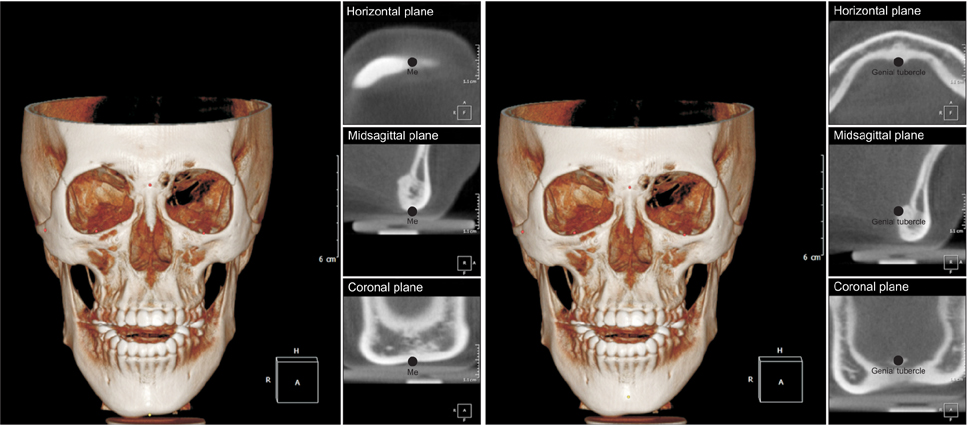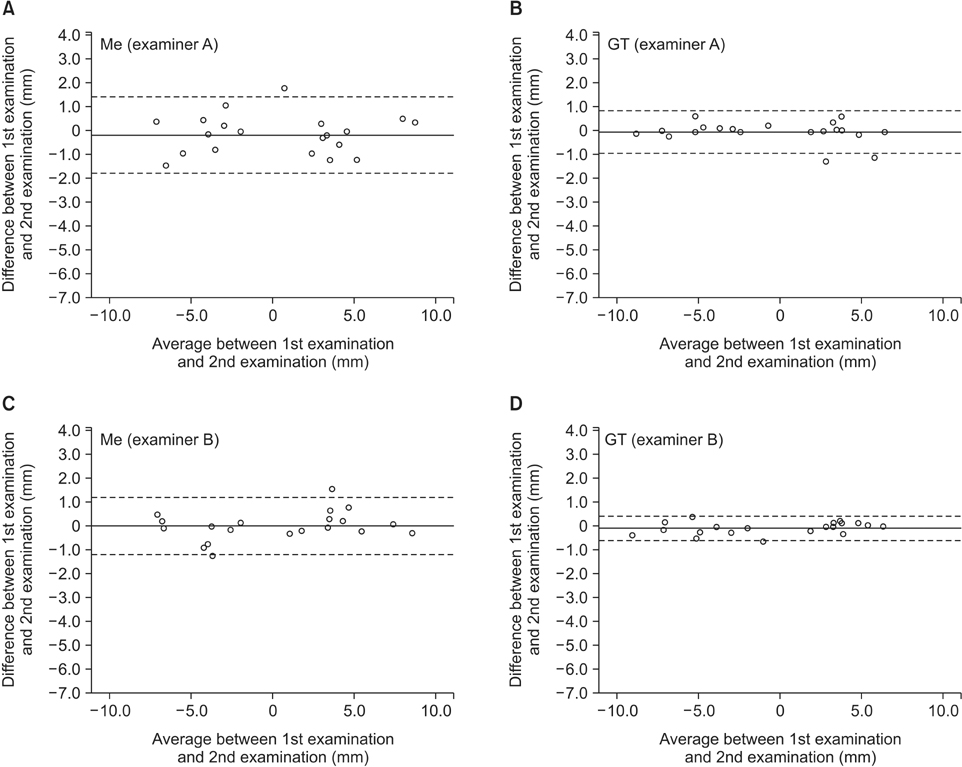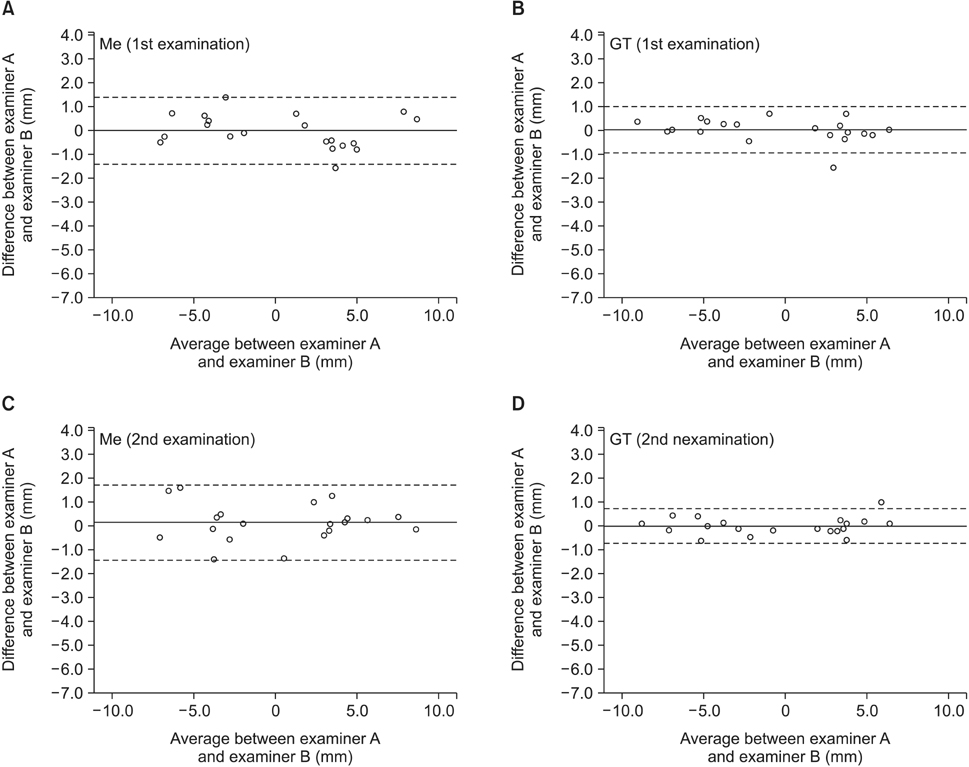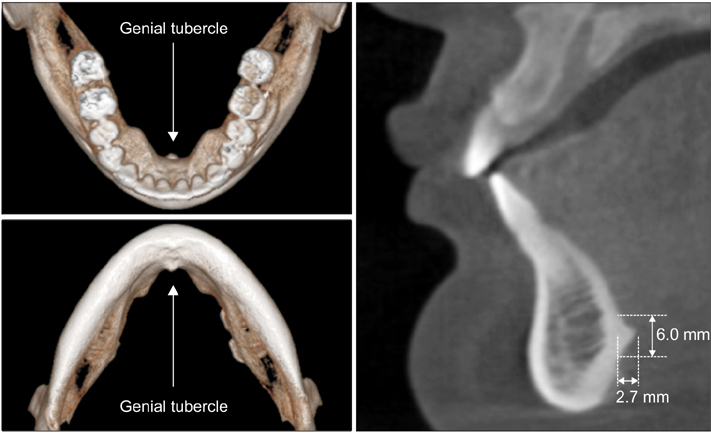Korean J Orthod.
2017 Jan;47(1):50-58. 10.4041/kjod.2017.47.1.50.
The genial tubercle: A prospective novel landmark for the diagnosis of mandibular asymmetry
- Affiliations
-
- 1Department of Orthodontics, School of Dentistry, Chonbuk National University, Jeonju, Korea.
- 2Department of Orthodontics, College of Dentistry, Gangneung-Wonju National University, Gangneung, Korea. korth@gwnu.ac.kr
- 3Research Institute of Oral Sciences, College of Dentistry, Gangnung-Wonju National University, Gangneung, Korea.
- KMID: 2392196
- DOI: http://doi.org/10.4041/kjod.2017.47.1.50
Abstract
- INTRODUCTION
Identifying menton (Me) on posteroanterior cephalograms and three-dimensional (3D) cone-beam computed tomography (CBCT) images is difficult, because the midpoint of the symphyseal area is not identifiable after the mandibular symphysis fuses at an early age. The aim of this study was to evaluate the reliability of the identification of the genial tubercle (GT) in patients with mandibular asymmetry and to compare it with that of the traditional landmark, Me.
METHODS
The samples comprised 20 CBCT images of adults with mandibular asymmetry. Two examiners performed the identifications and measurements. Me and GT were marked, and the anteroposterior, vertical, and transverse distances to the three reference planes were measured on 3D-reconstructed CBCT images. The intra- and inter-examiner reliability of landmark identification of Me and GT were assessed using the intraclass correlation coefficient (ICC) and Bland-Altman plots.
RESULTS
The Me and GT landmarks showed excellent reliability (ICC ≥ 0.993) three-dimensionally. In the transverse evaluation, the ICC values of the GT (range, 0.997-0.999) tended to be slightly higher than those of Me (range, 0.993-0.996). In the Bland-Altman plots for the two separate assessments, Me showed a maximum error of 1.76 mm in the transverse direction, whereas the GT showed a maximum error of 0.96 mm in the 95% limit.
CONCLUSIONS
Our results suggest that both Me and GT are clinically reliable and equally useful landmarks for the evaluation of mandibular asymmetry on CBCT images.
Figure
Cited by 1 articles
-
Comparison of the three-dimensional structures of mandibular condyles between adults with and without facial asymmetry: A retrospective study
Min-Hee Oh, Sung-Ja Kang, Jin-Hyoung Cho
Korean J Orthod. 2018;48(2):73-80. doi: 10.4041/kjod.2018.48.2.73.
Reference
-
1. Altemus LA. Horizontal and vertical dentofacial relationships in normal and class II division I malocclusion in girls 11-15 years. Angle Orthod. 1955; 25:120–137.2. Downs WB. Variations in facial relationships; their significance in treatment and prognosis. Am J Orthod. 1948; 34:812–840.
Article3. Ricketts RM. Cephalometric analysis and synthesis. Angle Orthod. 1961; 31:141–156.4. Shah SM, Joshi MR. An assessment of asymmetry in the normal craniofacial complex. Angle Orthod. 1978; 48:141–148.5. Vig PS, Hewitt AB. Asymmetry of the human facial skeleton. Angle Orthod. 1975; 45:125–129.6. Bayome M, Park JH, Kook YA. New three-dimensional cephalometric analyses among adults with a skeletal Class I pattern and normal occlusion. Korean J Orthod. 2013; 43:62–73.
Article7. Rhee CH, Choi YK, Kim YI, Kim SS, Park SB, Son WS. Correlation between skeletal and dental changes after mandibular setback surgery-first orthodontic treatment: cone-beam computed tomography-generated half-cephalograms. Korean J Orthod. 2015; 45:59–65.
Article8. Gribel BF, Gribel MN, Frazäo DC, McNamara JA Jr, Manzi FR. Accuracy and reliability of craniometric measurements on lateral cephalometry and 3D measurements on CBCT scans. Angle Orthod. 2011; 81:26–35.
Article9. Hassan B, van der Stelt P, Sanderink G. Accuracy of three-dimensional measurements obtained from cone beam computed tomography surfacerendered images for cephalometric analysis: influence of patient scanning position. Eur J Orthod. 2009; 31:129–134.
Article10. Kragskov J, Bosch C, Gyldensted C, Sindet-Pedersen S. Comparison of the reliability of craniofacial anatomic landmarks based on cephalometric radiographs and three-dimensional CT scans. Cleft Palate Craniofac J. 1997; 34:111–116.
Article11. van Vlijmen OJ, Maal TJ, Bergé SJ, Bronkhorst EM, Katsaros C, Kuijpers-Jagtman AM. A comparison between two-dimensional and three-dimensional cephalometry on frontal radiographs and on cone beam computed tomography scans of human skulls. Eur J Oral Sci. 2009; 117:300–305.
Article12. Jung PK, Lee GC, Moon CH. Comparison of cone-beam computed tomography cephalometric measurements using a midsagittal projection and conventional two-dimensional cephalometric measurements. Korean J Orthod. 2015; 45:282–288.
Article13. de Moraes ME, Hollender LG, Chen CS, Moraes LC, Balducci I. Evaluating craniofacial asymmetry with digital cephalometric images and cone-beam computed tomography. Am J Orthod Dentofacial Orthop. 2011; 139:e523–e531.
Article14. Sievers MM, Larson BE, Gaillard PR, Wey A. Asymmetry assessment using cone beam CT. A Class I and Class II patient comparison. Angle Orthod. 2012; 82:410–417.15. Hwang HS, Hwang CH, Lee KH, Kang BC. Maxillo-facial 3-dimensional image analysis for the diagnosis of facial asymmetry. Am J Orthod Dentofacial Orthop. 2006; 130:779–785.
Article16. Becker MJ. Mandibular symphysis (medial suture) closure in modern Homo sapiens: preliminary evidence from archaeological populations. Am J Phys Anthropol. 1986; 69:499–501.
Article17. Swennen GRJ, Schutyser FAC, Hausamen JE. Three-dimensional cephalometry: a color atlas and manual. Berlin: Springer Science & Business Media;2006.18. Schwarz AM. Lehrgang der Gebiβregelung. Band I: Untersuchungsgang (Diagnostik). Wien: Urban & Schwarzenberg;1951.19. Schulze C. Lehrbuch der Kieferorthopädie, Band 1. Berlin: Quintessenz Verlags;1980.20. Minich CM, Araújo EA, Behrents RG, Buschang PH, Tanaka OM, Kim KB. Evaluation of skeletal and dental asymmetries in Angle Class II subdivision malocclusions with cone-beam computed tomography. Am J Orthod Dentofacial Orthop. 2013; 144:57–66.
Article21. Kim SJ, Lee KJ, Lee SH, Baik HS. Morphologic relationship between the cranial base and the mandible in patients with facial asymmetry and mandibular prognathism. Am J Orthod Dentofacial Orthop. 2013; 144:330–340.
Article22. Nervina JM. Cone beam computed tomography usein orthodontics. Aust Dent J. 2012; 57:Suppl 1. 95–102.23. Lee BR, Kang DK, Son WS, Park SB, Kim SS, Kim YI, et al. The relationship between condyle position, morphology and chin deviation in skeletal Class III patients with facial asymmetry using cone-beam CT. Korean J Orthod. 2011; 41:87–97.
Article24. Williams FL, Richtsmeier JT. Comparison of mandibular landmarks from computed tomography and 3D digitizer data. Clin Anat. 2003; 16:494–500.
Article25. Fuyamada M, Nawa H, Shibata M, Yoshida K, Kise Y, Katsumata A, et al. Reproducibility of landmark identification in the jaw and teeth on 3-dimensional cone-beam computed tomography images. Angle Orthod. 2011; 81:843–849.
Article26. Lieberman DE, Crompton AW. Why fuse the mandibular symphysis? A comparative analysis. Am J Phys Anthropol. 2000; 112:517–540.
Article27. Wang YC, Liao YF, Li HY, Chen YR. Genial tubercle position and dimensions by cone-beam computerized tomography in a Taiwanese sample. Oral Surg Oral Med Oral Pathol Oral Radiol. 2012; 113:e46–e50.
Article28. Hueman EM, Noujeim ME, Langlais RP, Prihoda TJ, Miller FR. Accuracy of cone beam computed tomography in determining the location of the genial tubercle. Otolaryngol Head Neck Surg. 2007; 137:115–118.
Article29. Major PW, Johnson DE, Hesse KL, Glover KE. Landmark identification error in posterior anterior cephalometrics. Angle Orthod. 1994; 64:447–454.30. Bonett DG. Sample size requirements for estimating intraclass correlations with desired precision. Stat Med. 2002; 21:1331–1335.
Article
- Full Text Links
- Actions
-
Cited
- CITED
-
- Close
- Share
- Similar articles
-
- Genial tubercle position and genioglossus advancement in obstructive sleep apnea (OSA) treatment: a systematic review
- Skeletal pattern analysis of facial asymmetry patient using three dimensional computed tomography
- Three dimensional CT analysis of facial asymmetry
- Overview of Mandibular Condyle Fracture
- Quantification of three-dimensional facial asymmetry for diagnosis and postoperative evaluation of orthognathic surgery





